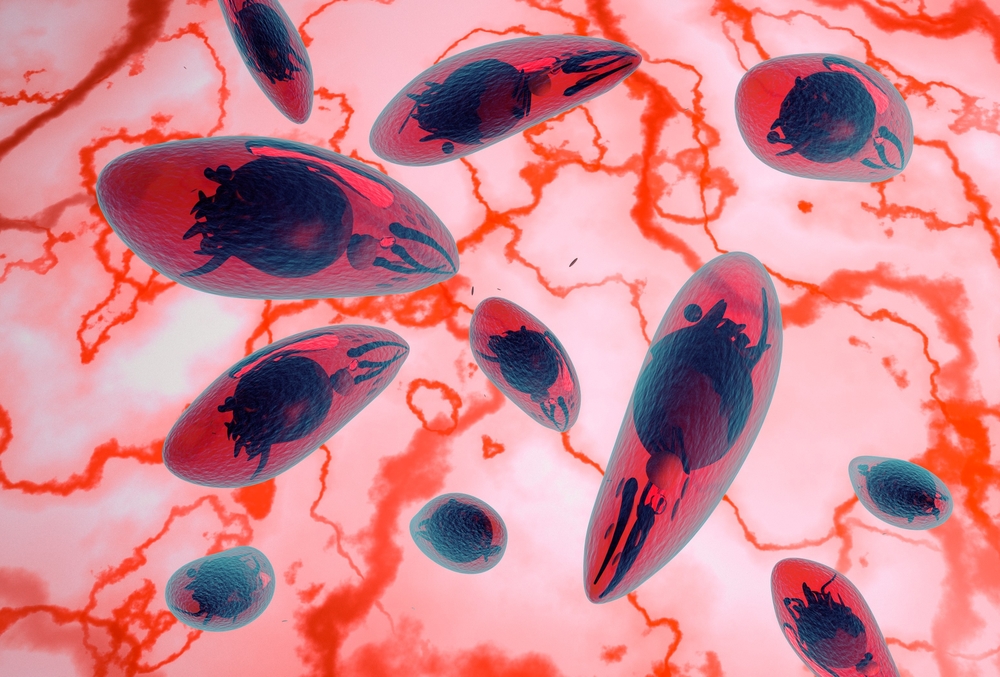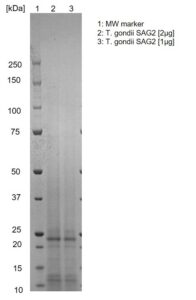SDS-PAGE: Coomassie-stained SDS-PAGE showing purified T. gondii SAG2.
Toxoplasma Gondii SAG2 Protein
Price range: $462.46 through $1,626.99 excl. VAT
Toxoplasma gondii SAG2 protein is a recombinant antigen manufactured in E. coli cells and is appropriate for use in immunoassay development and other applications.
TOXOPLASMA GONDII SAG2 PROTEIN
Toxoplasma gondii SAG2 protein is a recombinant antigen manufactured in E. coli cells for immunoassay development and other applications.
PRODUCT DETAILS – TOXOPLASMA GONDII SAG2 PROTEIN
- Recombinant Toxoplasma gondii SAG2 antigen.
- Full-length protein with a 6xHis-tag at its C-terminus.
- Expressed and purified from E. coli cells.
- Presented in phosphate buffered saline.
BACKGROUND
Toxoplasma gondii is an obligate intracellular protozoan parasite, associated with severe congenital defects and life-threatening infection in immunocompromised hosts. In humans, T. gondii infection in pregnant women can result in congenital infection, such as late-onset eye disease. It is also a frequent cause of encephalitis in AIDS patients; in animals, the infection can cause a variety of diseases and symptoms (Smith, 1995). There are four functionally distinct forms of T. gondii, known as tachyzoite, bradyzoite, merozoite and sporozoite and there is considerable variation in their cell tropism. Tachyzoites rapidly proliferate and quickly disseminate within the host, indiscriminately infecting many cell types in the process. Bradyzoites slowly grow within cysts located in brain and muscle tissue and can infect new hosts upon ingestion. Merozoites result from asexual division in feline enterocytes, which is necessary to increase parasite density prior to sexual development. Sporozoites are the product of the sexual phase and like bradyzoites can establish an infection upon ingestion (Lekutis et al., 2001).
The surface of T. gondii tachyzoites and bradyzoites is covered with glycosylphosphatidylinositol (GPI)-anchored antigens, most of which are members of the surface antigen 1 (SAG1) or SAG2 families. These molecules appear to play a role in host cell invasion, immune modulation and/or virulence attenuation, although they may also provide protection needed by the parasite to survive in the environment. SAG2 is an intrinsically unstructured protein, which can interact with many cellular and surface molecules of infected host (Lekutis et al., 2001). It shows good antigenicity and immunogenicity and recombinant SAG2 is an effective antigen to detect IgG to T. gondii in human patients with acute toxoplasmosis. It is also used as an antigen in ELISA to test for T. gondii infection in domestic cats. It has also been shown that recombinant SAG2 could provide partial protection against a lethal infection of T. gondii and inhibited cyst formation in the brains of infected mice.
REFERENCES
- Lekutis C, Ferguson DJ, Grigg ME, Camps M, Boothroyd JC. Surface antigens of Toxoplasma gondii: variations on a theme. Int J Parasitol. 2001;31(12):1285–1292.
- Smith JE. A ubiquitous intracellular parasite: the cellular biology of Toxoplasma gondii. Int J Parasitol. 1995;25(11):1301–1309.


